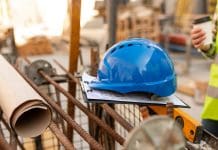Ben Griffiths, operations director of the Rye Group, talks about the current state/challenges of the demolition industry and what it should expect in 2022
-
We’ve seen the construction industry’s output fluctuating in the past year, with longer delivery times over the summer followed by a sharp rise in activity by November. Has there been a similar story in the world of demolition?
It has been an odd year in some ways for the demolition industry. For large parts of the year we have been extremely busy, there has been a huge amount of energy and movement with new ideas and projects coming along.
Our Managing Director, Simon Barlow, is the Vice Chairman of the National Demolition Training Group and is closely involved with the NFDC, so is very close to many conversations and, around the energy and passion, there is a mixed picture.
We had a very busy start to 2021 and are currently rolling out new programmes of work all over London and the Home Counties. That said, we definitely noticed the middle two quarters of the year were marked by hesitancy. Ongoing conversations for projects due to start in Q2 ended up extending through to Q4 and so on.
The important point to note though is that, despite the slow progress of many procurement rounds, projects proceeded and contracts awarded – demonstrating continued growth in the demolition industry.
-
These fluctuations are caused by a variety of factors, including supply chain issues and the pandemic. How have supply chain problems impacted your work?
The hesitancy to proceed has, without doubt, been impacted by a range of MACRO environmental factors such as Brexit, the pandemic and friction between China, Russia and the West.
From a supply chain perspective, our major challenge relates to labour shortages. Sources suggest that 1.3m EU nationals returned to their native countries through Brexit and the pandemic, creating labour shortages in many industries. There are also reports of a 36% drop in job searches by EU nationals, an important source of staffing in recent years. With this in mind, there is an added need for us to recruit new blood into the industry and train the next generation of demolition professionals.
The slow down of contract awards is likely down to the uncertainty of market conditions for construction firms. It is well reported that material costs are increasing, interest rates are on the verge of an uptick and employment levels are unsure as people return (or not) from furlough. Uncertain market conditions mean developers are taking time to evaluate the best path forward and, while decisions are being made at the moment, we wouldn’t be surprised to see further slow-downs and stutters in the coming months as we deal with new Covid variants, possible restrictions and the growing uncertainty of relationships with China, Russia and OPEC nations – all having knock-on implications to the global supply chain.
-
Moving on to the pandemic, has the demolition industry been uniquely affected by the precautions and mitigations the pandemic brings? And if so, how?
The demolition industry is a resilient and adaptable industry and, in many ways, able to continue operating throughout a pandemic because much of the work is outside or conducted in isolation with individuals driving plant and machinery solo. We were able to put in place measures to ensure safe operation easily, though not without cost.
We are a safety-first industry, and so are well-positioned to respond to new risks and put in place measures to mitigate those risks and continue operating.
The main impact in truth has been a knock-on from other sectors of the economy, with construction slowdowns and labour challenges that we’ve already discussed.
Our ability to adapt as a company and as an industry has been vital to our survival, but this doesn’t run throughout the economy so, as with every industry, we have not been immune to the pandemic.
-
On the subject of precautions: what kind of health and safety challenges have you needed to address over the past couple of years?
As I mentioned previously, we’re always keeping abreast of health and safety matters, as the demolition industry is inherently high risk if not controlled.
Sadly, injuries and deaths occur from time to time in the wider industry and so we look to learn from those, with major cases often paving the way for reviews of best practices.
One new piece of guidance from the NFDC covers exclusion zones, laying out new measures to improve safety and reduce incidents. We are also further exploring, not only the practical nature of health and safety but the behavioural side – i.e. the human factor.
While staff are trained and certifications kept up to date, accidents can happen due to someone switching off or through a misunderstanding. We are going to be looking further into this so that practical measures such as signage, exclusion zones, mechanical safety and cut out systems, warning signals and PPE have the best chance of protecting our colleagues.
The other major area has, of course, been Covid, to which we responded swiftly by implementing measures such as temperature checks, larger welfare cabins to enable social distancing, hand sanitisation cross-site, the requirement to wear masks when working in teams and the requirement to work 2m apart whenever possible. We also deployed Covid champions and marshals, as well as Covid branded PPE across our sites to maintain focus on safe working practices.
-
‘Challenges’ will, no doubt, remain the watchword of 2022 – do you foresee any particular challenges over the next 12 months for the demolition field in particular?
I have previously mentioned challenges surrounding wider economic matters and labour shortages but an area for consideration, that we are already focusing on, is environmental. We are eager to make a positive impact wherever we work and reduce our carbon footprint and are already on the march, having deployed HVO across our fleet to replace diesel, thus reducing emissions by as much as 90%. It is likely that legislation will ensue for the industry and the industry will need to adapt. Already subsidies on red diesel are being removed and we may well see levies on other pollutants as well as incentives being put in place for increased re-use and recycling practices.
The pressure will not only come through direct legislation but also through the requirement of our clients (developers) to work with environmentally conscious contractors committed to their objectives around carbon reduction.
-
The pandemic has resulted in a lot of political rhetoric around ‘building back better’ – what part can the demolition industry play in contributing towards this kind of outlook?
The demolition industry is uniquely placed to contribute to economic recovery. We are great enablers of the economic cycle by creating significant opportunities for people and communities to regenerate and create new opportunities.
Many of our projects involve the demolition of tired or dilapidated town centres and residential zones in preparation for redevelopment, leading to new jobs, enhanced living space and vibrant community space.
We regularly employ local labour and, through our work, have a tangible impact on the communities in which we work before redevelopment begins. Without the demolition industry the ‘build’ element of ‘build back better’ could not occur, so we feel proud and privileged to play our part.
-
Final question: what developments in technology or practice have got you excited for the future of the industry?
Many people may be surprised that demolition is not a wrecking ball swinging into a building in spectacular fashion or blowdowns triggered by a cartoon character and a red button. Our work is highly controlled, meticulously planned and precise – though blowdowns do take place in certain situations!
As technology progresses we are always looking for new ways to streamline our work and make it even more precise, from GPS enabled earthmovers to targeted water dampening systems – there are many opportunities that we remain alert to.
The biggest watch area, however, is likely to be green plant and machinery. If we are to deliver the emission reductions that are needed as a country then plant, machinery and commercial vehicles need to be able to run efficiently and effectively on green fuels such as sustainable electricity and hydrogen, or at least through hybrid technology. We will be keeping a close eye on the availability of such equipment that performs as it needs to.






![[VIDEO]What to expect when you’re inspecting: Using DorTrak for fire door inspections](https://www.pbctoday.co.uk/news/wp-content/uploads/2025/02/maxresdefault-218x150.jpg)






